List of South African flags
This article lists the flags of the various colonies and states that have existed in South Africa since 1652.
Overview
The following flags have been used as the national flag of the Union of South Africa and the Republic of South Africa:
| Flag | Date | Description |
|---|---|---|
.svg.png.webp) | 1910–1912 | A British Red Ensign with the shield of the coat of arms of the Union of South Africa. |
.svg.png.webp) | 1912–1928 | A British Red Ensign with the shield of the coat of arms of the Union of South Africa on a white roundel. |
.svg.png.webp) | Flag of South Africa 1928–1994 | Orange, white, and blue horizontal stripes, on the white stripe, a backwards Union Flag towards the hoist, the Orange Free State flag hanging vertically and the Flag of Transvaal, towards the fly. Used for both the Union and later Republic of South Africa |
 | Flag of South Africa 1994–present | Two horizontal bands of chilli red (top) and blue (bottom) with a black triangle at the hoist, over all a green horizontal (pall) (Y-shape), fimbriated white against the red and blue and gold against the black. |
History
Historical flags (1652–1928)
- Many flags were used in South Africa prior to political unification in 1910.
- The original Dutch East India Company colony at the Cape of Good Hope (1652–1795) flew the Dutch flag, with the VOC logo in the centre. This flag was also flown during the period of Batavian Republic rule (1803–06).
- The Boer Republics, i.e. the Orange Free State (1854–1902), the South African Republic (1857–1902), Stellaland (1882–85), Goshen (1883–85), the Nieuwe Republiek (1884–88), and the Klein Vrystaat (1886–1891) had their own flags. Several derived from the Dutch flag.
- The British colonies that existed in the 19th century flew the British flags, and from the early 1870s some, i.e. Natal, Cape Colony, and later the Orange River Colony and the Transvaal, added their own colonial flag badges.
- The Union of South Africa, formed in 1910, initially used a red ensign defaced with a badge depicting the Union coat of arms. The first South African national flag, introduced in 1928, superseded it.
| Flag | Date | Use | Description |
|---|---|---|---|
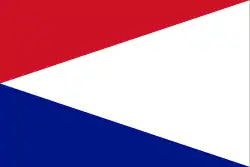 | 1839–1843 | Natalia Republic | |
 | 1857–1902 | Orange Free State | |
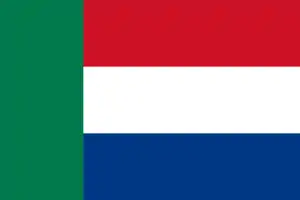 | 1857–74, 1875–77, 1881–1902 | South African Republic (Transvaal Republic) | ('Vierkleur') |
 | 1874–1875 | South African Republic (Transvaal Republic) | ('Thomas François Burgers's Voortrekker flag'). A red saltire outlined in white on a dark blue field. |
.svg.png.webp) | 1875–1910 | Colony of Natal | |
.svg.png.webp) | 1876–1910 | Cape Colony | A blue ensign defaced with the shield-of-arms of Cape Colony |
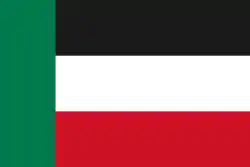 | 1883–1885 | State of Goshen | |
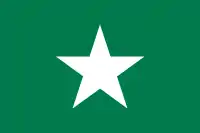 | 1883–1885 | Stellaland | |
 | 1884–1888 | Nieuwe Republiek | |
 | 1890–1891 | Klein Vrystaat | |
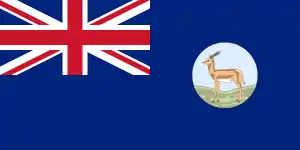 | 1902–1910 | Orange River Colony | A blue ensign defaced with a springbok antelope in a disc[1] |
.svg.png.webp) | 1904–1910 | Transvaal Colony | A blue ensign defaced with a disc showing a lion lying on an African plain with palm trees.[2] |
.svg.png.webp) | 1910–1912 | Union of South Africa (Merchant flag) | |
.svg.png.webp) | 1910–1951 | Union of South Africa (State Ensign) | |
.svg.png.webp) | 1912–1951 | Union of South Africa (Merchant flag) |
National flag (1928–1994)
- The Hertzog administration introduced the flag after several years of political controversy. Approved by Parliament in 1927, it was first hoisted on May 31, 1928.
- The flag reflected the Union's predecessors. The basis was the Prince's Flag (royal tricolour) of the Netherlands, with the addition of a Union Jack to represent the Cape and Natal, the former Orange Free state flag, and the former South African Republic flag.
- Until 1957, the flag was flown subordinate to the British Union Jack.
- The flag remained unchanged when South Africa became a republic on May 31, 1961. However, there was pressure to change the flag, particularly from Afrikaners who resented the fact that the Union Flag was a part of the flag. The then prime minister, Dr Hendrik Verwoerd, had a "clean" flag, comprising three vertical stripes of orange, white, and blue, with a leaping springbok over a wreath of six proteas in the centre, designed, but he was assassinated before he could introduce it, and the project died with him in 1966.
| Flag | Date | Use | Description |
|---|---|---|---|
.svg.png.webp) | 1928–1982 | Republic/Union of South Africa | The flag using a darker shade of "Union" blue common before the early 1980s. |
.svg.png.webp) | 1982–1994 | Republic of South Africa | The flag using a lighter shade of "Solway" blue as specified by the South African government in 1982. |
Homeland flags (1966–1994)
- Nine of the ten Black 'homelands' which were created inside South African Federation under the apartheid system, had their own flags, i.e. Transkei (1966–94), Bophuthatswana (1973–94), Ciskei (1973–94), Gazankulu (1973–94), Venda (1973–94), Lebowa (1974–94), QwaQwa (1975–94), KwaZulu (1977–94), and KwaNdebele (1982–94). KaNgwane was the only homeland that never adopted its own distinctive flag, instead using the national flag of South Africa.
- All these flags became obsolete when South Africa reincorporated the homelands on April 27, 1994.
| Flag | Date | Use | Description |
|---|---|---|---|
 | 1966–1994 | Transkei | |
.svg.png.webp) | 1973–1994 | Bophuthatswana | |
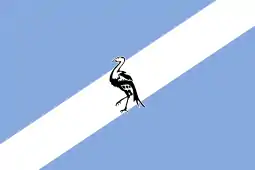 | 1973–1994 | Ciskei | |
 | 1973–1994 | Gazankulu | |
.svg.png.webp) | 1973–1994 | Venda | |
 | 1974–1994 | Lebowa | |
.svg.png.webp) | 1975–1994 | QwaQwa | |
.svg.png.webp) | 1977–1985 | KwaZulu (1) | |
 | 1982–1994 | KwaNdebele | |
.svg.png.webp) | 1985–1994 | KwaZulu (2) |
Sporting flags (1992–1994)
As a result of the sporting boycott of South Africa over its policy of apartheid, South Africa did not participate in the Olympic Games between 1964 and 1988. The country was re-admitted to the Olympic movement in 1991.[3] As a result of a dispute over what flag and national anthem to use following readmission, the team participated in the 1992 Summer Olympic Games under a specially designed sporting flag. The flag consisted of a white field charged with grey diamond, which represented the countries mineral wealth, three cascading bands of blue, red and green, which represented the sea, the land and agriculture respectively, the Olympic rings and the name of the team underneath.[4][5] Team uniforms included the emblem of Olympic Committee of South Africa, which depicted Olympic rings surrounded by olive branches, with the name of the country above. The team would use Beethoven's "Ode to Joy" as its victory anthem at these games. At the 1994 Winter Game, South Africa participated under the flag of its Olympic committee.
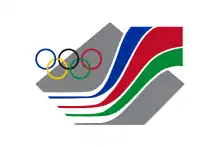 Flag used to represent the South African team at the 1992 Summer Olympic Games
Flag used to represent the South African team at the 1992 Summer Olympic Games Flag used to represent the South African team at the 1994 Winter Olympic Games
Flag used to represent the South African team at the 1994 Winter Olympic Games
National flag (1994–present)
- South Africa was reconstituted as a unitary democratic state, with equal rights for men and women of all races in 1994. The old flag's long association with the apartheid era made it unacceptable for the new dispensation, and the State Herald, Frederick Brownell therefore designed a new flag. Approved by the Transitional Executive Council (TEC) on March 20, 1994, and officially authorised by state president F. W. de Klerk on April 20, 1994, it was officially hoisted a week later, on April 27, 1994.
- The new flag was intended as an interim measure, but it proved so popular that when the final Constitution was prepared in 1996, it became the permanent flag.
| Flag | Date | Use | Description |
|---|---|---|---|
 | 1994–present | Republic of South Africa |
Governmental flags
.svg.png.webp) Governor of the Cape Colony, 1876–1910
Governor of the Cape Colony, 1876–1910.svg.png.webp) Governor of the Natal Colony, 1905–1907
Governor of the Natal Colony, 1905–1907.svg.png.webp) Governor of the Orange River Colony, 1902–1910
Governor of the Orange River Colony, 1902–1910.svg.png.webp) Governor of the Transvaal Colony, 1904–1910
Governor of the Transvaal Colony, 1904–1910.svg.png.webp) High Commissioner for Southern Africa, 1907–1931
High Commissioner for Southern Africa, 1907–1931.svg.png.webp) High Commissioner for Southern Africa, 1931–1968
High Commissioner for Southern Africa, 1931–1968.svg.png.webp) Governor-General of South Africa, 1910–1931
Governor-General of South Africa, 1910–1931.svg.png.webp) Governor-General of South Africa, 1931–1952
Governor-General of South Africa, 1931–1952.svg.png.webp) Governor-General of South Africa, 1952–1961
Governor-General of South Africa, 1952–1961.svg.png.webp) State President of South Africa, 1961–1984
State President of South Africa, 1961–1984.svg.png.webp) State President of South Africa, 1984–1994
State President of South Africa, 1984–1994
Civil Air Ensign
.svg.png.webp) 1930s
1930s
Military flags
South African Defence Force
.svg.png.webp) 1947–1981
1947–1981.svg.png.webp)
South African National Defence Force
.svg.png.webp) 1994–2003
1994–2003 2003–present
2003–present
National Defence Department
South African Army
.png.webp) 1951–1973
1951–1973.svg.png.webp) 1973–1994
1973–1994.svg.png.webp) 1994–2002
1994–2002.svg.png.webp) 2002–2003
2002–2003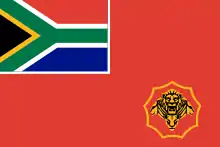 2003–present
2003–present
South African Air Force
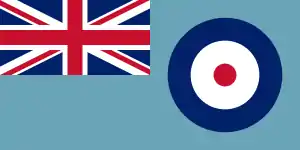 1920–1940
1920–1940.svg.png.webp) 1940–1951
1940–1951.svg.png.webp) 1951–1958
1951–1958.svg.png.webp) 1958–1967
1958–1967.svg.png.webp) 1967–1970 (approved but not used)
1967–1970 (approved but not used).svg.png.webp) 1970–1981
1970–1981.svg.png.webp) 1981–1982
1981–1982.svg.png.webp) 1982–1994
1982–1994.svg.png.webp) 1994–2003
1994–2003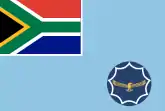 2003–present
2003–present
South African Navy
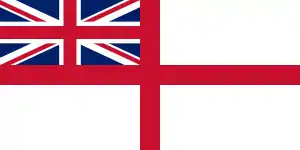 Naval ensign, 1922–1946
Naval ensign, 1922–1946.svg.png.webp) Naval ensign, 1946–1951
Naval ensign, 1946–1951.svg.png.webp) Naval ensign, 1951–1952 (approved but not used)
Naval ensign, 1951–1952 (approved but not used).svg.png.webp) Naval ensign, 1952–1959
Naval ensign, 1952–1959.svg.png.webp) Naval ensign, 1959–1981
Naval ensign, 1959–1981.svg.png.webp) Naval ensign, 1981–1994
Naval ensign, 1981–1994.svg.png.webp) Naval colour, 1981–1994
Naval colour, 1981–1994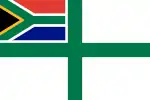 Naval ensign, 1994–present
Naval ensign, 1994–present.svg.png.webp) Naval colour, c. 1998
Naval colour, c. 1998
Provincial flags
1910–1994
Between 1910 and 1994, South Africa was divided into four provinces, Cape Province, Natal, Orange Free State and Transvaal. These provinces had their own coat of arms but not their own flags.
1994–present
In April 1994, South Africa was divided into nine provinces. Each province was granted a coat of arms, in most cases designed by State Herald Frederick Brownell. Currently only one province, Mpumalanga, has adopted an official provincial flag, doing so in February 1996.[6] The other eight provinces can be represented by white banners charged with their coats of arms.
 Banner of Eastern Cape
Banner of Eastern Cape Banner of Free State Province
Banner of Free State Province Banner of Gauteng
Banner of Gauteng Banner of KwaZulu-Natal
Banner of KwaZulu-Natal Banner of Limpopo
Banner of Limpopo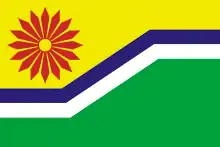
 Banner of North West Province
Banner of North West Province Banner of Northern Cape
Banner of Northern Cape Banner of Western Cape
Banner of Western Cape
Proposed flags
Flags proposed in the 1920s
 Committee proposal 1
Committee proposal 1 Committee proposal 2
Committee proposal 2 Committee proposal 3
Committee proposal 3
Designs shortlisted by the Commission on National Symbols
The Commission on National Symbols proposed six designs in October 1993.[7]
 Proposal 1
Proposal 1 Proposal 2
Proposal 2 Proposal 3
Proposal 3 Proposal 4
Proposal 4 Proposal 5
Proposal 5 Proposal 6
Proposal 6
Designs Proposed Graphic design studios
A group of professional graphic design studios proposed several flag designs in November 1993.[8]
Designs shortlisted by the Joint Technical Working Committee
The Joint Technical Working Committee shortlisted 5 designs in February 1994. A further design was proposed also by the African National Congress (ANC) based on a design shortlisted in October 1993. Proposal 4, designed by State Herald Frederick Brownell, was submitted to the Transitional Executive Council and approved as the final choice for the new flag.[9]
 Proposal 1
Proposal 1 Proposal 2
Proposal 2 Proposal 3
Proposal 3 Proposal 4
Proposal 4 Proposal 5
Proposal 5.svg.png.webp) Proposal by ANC
Proposal by ANC
See also
Notes
- This replaced the Orange Free State republican flag.
- The flag is the colonial flag which replaced the "Vierkleur" of the South African Republic (horizonally red, white and blue with a vertical green stripe at the hoist).
- https://gulfnews.com/today-history/july-23-1992-south-africa-returns-to-olympics-after-32-years-1.2062619
- https://www.crwflags.com/FOTW/flags/za@olymp.html
- https://gulfnews.com/today-history/july-23-1992-south-africa-returns-to-olympics-after-32-years-1.2062619
- https://www.crwflags.com/fotw/flags/za-mp.html
- https://repository.up.ac.za/xmlui/bitstream/handle/2263/50847/Brownell_Convergence_2015.pdf?sequence=1&isAllowed=y
- https://repository.up.ac.za/xmlui/bitstream/handle/2263/50847/Brownell_Convergence_2015.pdf?sequence=1&isAllowed=y
- https://repository.up.ac.za/xmlui/bitstream/handle/2263/50847/Brownell_Convergence_2015.pdf?sequence=1&isAllowed=y
References
- Beckett, D. (2002) Flying with Pride.
- Brownell, F.G. (1993) National and Provincial Symbols.
- Burgers, A.P. (1997) Sovereign Flags of South Africa.
- Burgers, A.P. (2008). The South African Flag Book.
- Pama, C. (1965) Lions and Virgins.
- Pama, C. (1984) Die Vlae van Suid-Afrika.
External links
| Wikimedia Commons has media related to Flags of South Africa. |









